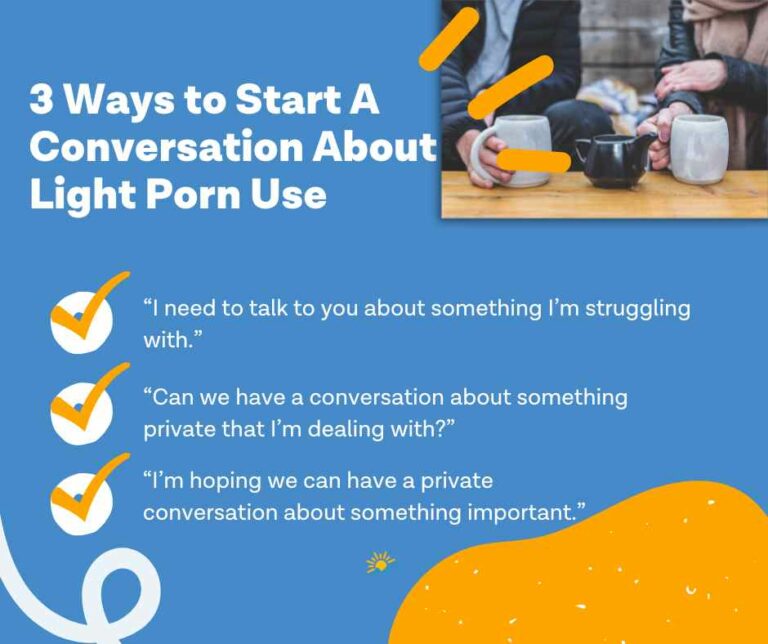There’s one thing about porn recovery that just about everyone understands – talking to people and getting support from those around you helps. We all intrinsically understand this. We all know that getting the support of others, whether they be loved ones or trusted professionals, will only build resources and help people on the road to recovery.
However, those with mild or inconsistent porn habits sometimes struggle to have open and honest conversations with others about their porn use. Because of this, they also often have fewer social resources and less social support in their recovery and efforts to stop light porn use than sometimes even those with more severe pornography addictions.
This conversation starter guide is meant to do two things. First, we want to help you understand why talking to others about a less frequent porn habit might be challenging. Second, we’ll give you a simple yet effective conversation starter guide to help you initiate that first conversation about your porn use with another person.
Why is disclosing light porn use so hard?

You might assume that talking about heavy pornography use or pornography addiction would be harder than talking about an off-and-on again or inconsistent porn habit. But that’s not always the case. The reason is because of how shame works. Shame is one of the main reasons we aren’t honest and open with others. Shame makes us worried that we’ll be judged or looked down on for our decisions or actions.
When someone is struggling with a pornography addiction, they often know they have lost control. They know they need help and support, and they know they probably can’t recover on their own. In many cases, this is enough to push someone to start seeking help and talking to others, whether it be a spouse, friend, or counselor.
With lighter porn use, this same sense of urgency and lack of control is often lacking. If you have an inconsistent porn habit, you’ve likely felt like it’s something you should just be able to take care of on your own. You feel like you shouldn’t need someone else’s help.
Since there may be no consistency or pattern to your use, you know you’re not addicted, so it shouldn’t be that hard to stop, right? Sound familiar? If so, you’re not alone. Because those with inconsistent porn habits often feel like they should have more control than they do and feel like they shouldn’t really need outside help or assistance to stop, the negatives of sharing or talking to someone sometimes feel like they outweigh the positives.
But here’s a secret. Porn is addictive for a reason! Even if you haven’t developed compulsive behavior attached to porn, it’s still a stimulus to your brain that can be hard to shake, like any bad habit. Having support around you and having accountability in your life will only help strengthen your resolve to stop using porn! Plus, being open and honest with others around us will only strengthen those relationships if we commit to honesty and being vulnerable.

Who do I talk to?
The decision of whom to talk to about your pornography habit is a personal one. Obviously, you’ll be sharing something about yourself that is personal and somewhat embarrassing. The answer of who is the best person to start with is different for every person.
Here are a few questions to ask yourself as you consider people in your life that might be a strong support system for you:
- Does this person love and care about me?
- Does this person have my best interests in mind?
- Will this person respond to me with love and kindness?
If the answer to all three of these questions is “yes”, you have yourself a strong candidate for a supporter.

If you are married, we always recommend you strongly consider sharing your pornography habit with your spouse, if you have not done so already. Hiding and lying about pornography in a marriage is a recipe for problems down the road. While it may be hard, bringing pornography use out of the darkness and into the light is the only way to develop a truly strong and stable relationship in the future.
We’ll add some specific guidance for you below if you are having this conversation with your spouse.
A Conversation Guide for light porn users
Hopefully at this point you have someone in mind that you’d like to have this challenging but important conversation with. With that person in mind, let’s guide you through the steps of having a healthy conversation about your porn use.
Phase 1: Prep Work
Before you have this important discussion, there’s some prep work to be done first. This means there are some things you need to do before the conversation happens to ensure that the conversation is as likely as possible to be a positive and productive one. There are three key parts to this prep work. Let’s cover them one by one.
The Setting:
The first thing you need to think about is the proper setting for this conversation. Where and when are you going to have it? When you approach this person about having a conversation, you should have a potential time and location picked out to suggest. Of course, be flexible as needed and be generous toward the other person’s schedule. Having this conversation in the right setting will go a long way to increasing the odds of a positive interaction.
First off, think about what the current context of the person’s life is you want to talk to. Are they stressed about someone going on in their life (perhaps an upcoming work project or extended family coming into town)? If so, it may not be the best time to have a stressful conversation (but don’t use this as an excuse to delay the conversation forever).
Next, think about a setting you could have the conversation in that would be peaceful and quiet. Is there a specific location that means something to both of you? Another thing to keep in mind is to avoid settings with children (yours or others) that may not allow you to speak openly. Generally, you should try to find a setting where you can be alone and not disturbed.
The Invitation:
Once you have a setting in mind, it’s time to ask the person if you can have a conversation. As you do this, remember that one of the goals of this conversation is to not have it begin with negative energy or on a sour note. To help that, you want to make sure the person that you are speaking to doesn’t start the conversation in a stressful state.
There’s almost nothing more stressful than being asked to have a “serious conversation”, yet having no idea what it’s about. You need to give the person you’re talking to a heads-up about the topic. That doesn’t mean you need to confess your porn use before the meeting. But you should use phrases like:
- “I need to talk to you about something I’m struggling with.”
- “Can we have a conversation about something private that I’m dealing with?”
- “I’m hoping we can have a private conversation about something important.”
What if the person you’re asking to have the conversation presses for details?
It’s appropriate to say you’re not comfortable getting into details now, but that the reason you’d like to schedule some time to talk is to get into the details.
The Attitude:
Once you have the conversation scheduled, the final piece of preparation is all about your attitude. While the attitude of both people in the conversation is important, you can only control how you approach the conversation. You need to keep a few things in mind.
First and foremost, approach the conversation in the spirit of honesty. Avoid what some experts call “toe-dipping” honesty. This means you reveal small truths to see what the reaction of the person is (like dipping your toe into the pool to check the temperature).
The problem with this approach is two-fold. First, it’s not giving the person you’re talking to all the information about your situation, meaning they will be limited in how they are able to help and support you. Secondly, it is highly likely that the whole truth will eventually come out. When that happens, the person you’re talking to may feel like you were being deceptive or dishonest in this initial conversation by not disclosing the whole truth.
In addition to being committed to honesty, it is also important to approach these conversations with an attitude of humility. This will help you avoid one of the most common problems in these types of conversations, getting defensive. You’ll want to avoid getting defensive because this will make your communication with this person more critical and less collaborative.
Remember, you’re having this conversation seeking help and support. Make sure you are willing to hear someone’s thoughts on how you might need to change or what actions you might take to recover. This doesn’t mean you have to automatically do everything they tell you to do, but you should have an attitude of being humble and willing to listen to anothers’ perspective.
The final thing to note about your attitude as you approach this conversation is to not be expecting a “quick-fix”. You need to approach this conversation assuming it will be the first of many. Don’t put too much pressure on this single conversation. Don’t expect everything to be figured out or to get better after one interaction. Think about this as a starting point for open communication. This will help keep your expectations realistic as you start communicating.

Phase 2: Having the talk and understanding the structure of the conversation
Any healthy conversation has a structure to it. This goes beyond a simple beginning, middle, and end. Like the preparation you did before the conversation happened, having a well-structured outline of the conversation in mind before you begin will help you stay on track and help reduce your anxiety during the conversation. If you know what to expect and what topics you need to cover, you can make sure to get the most out of this interaction.
We’re going to break down the conversation into two broad parts: the start of the conversation and then the “meat” of the conversation (this is what will take most of the time during the conversation). We’ll guide and prepare you for each step across both parts of the conversation.
Part 1: Starting the conversation about light porn use
As you begin the conversation, it’s normal to feel anxiety and some stress. You’re venturing into unknown territory, and no matter how well you know the person you’re speaking too, you likely haven’t had this type of conversation before. You’re not going to be exactly sure how they will react.
We’ll assume that you’ll be taking charge at the beginning of the conversation. After all, you asked for the conversation in the first place. Let’s get down to the specific steps you’ll want to take as you begin the conversation. Remember, you are a unique person with a unique story. Adapt these steps as needed to fit the unique context of your background.
Step 1: Don’t “bury the lead”.
Perhaps the easiest mistake to make in this conversation is to take too long to build up to the main point – you are struggling with pornography and want help and support. As we already mentioned, sometimes this can happen because we only dip our toe into the conversational waters to test the other person’s reaction.
Sometimes stress gets the best of us, and we can’t quite get the words out. Whatever the reason, you need to immediately begin the conversation by clearly stating what the issue is.
Take a breath! Yes, that means you need to start the conversation by telling the person you’re talking to that you a) have a pornography problem and b) want to talk about what’s been happening because you want help and support. Be prepared! The person you’re talking to may have a surprised and even emotional reaction. They likely will have a lot of questions.
If so, ask if you can give them the background of your story first, and then you can answer any questions they have. This will allow you to make sure you give the other person all the relevant details instead of being guided solely based on the questions they ask. Be clear that you want to answer their questions, but that you think it will be helpful if you can give them some context first.
Step 2a. Give adequate background.
The next step is to tell your story. You don’t need to get into every detail of every porn video you’ve ever watched. But you do want to make sure the person you’re talking to understands your history of pornography and your perspective on what’s happened and why.
Start by giving them a broad background into your pornography use. Consider the following questions and incorporate your answers into the background you give them:
- When did you first get introduced to pornography?
- How old were you?
- What was the setting?
- What has been your general pattern of use over the years?
- Has it stayed consistent or changed?
- Did you have periods of abstinence?
- When relapses have happened, why do you think they occurred?
- What has changed and stayed the same about your pornography pattern over the years?
Step 2b. Give clear current context.
The next thing you’ll want to do is give the person you’re talking to a clear picture of what pornography use looks like right now. By “right now,” we mean the recent past, probably over the last few weeks. Again, consider the following questions and incorporate your answers into your story:
- When was the last time you viewed pornography?
- What is your current pattern over the last few weeks or months?
- Do you currently feel like you’re struggling with the urge to watch pornography, or are you mostly worried about what might happen in the future?
Step 2c. Give clear requests.
The final aspect of this first part of the conversation is to end your story with a clear set of requests you have for this person. At this point in the conversation, this doesn’t have to be specific, but you want to be clear about what you’re hoping this person can do to support.
- Are you looking for someone to talk to?
- Are you looking for an accountability partner who can check up on you?
- Do you simply want to be open and honest in the relationship moving forward?
Whatever your specific desires are, make sure to articulate them after giving an honest and clear account of your pornography history.
Part 2: The Meat of the Conversation
At this point in the conversation, you’ve likely been doing a lot, if not most, of the talking. It’s now time to sit back and listen. The next thing that should happen is that you will ask the person you’re talking to if they have any questions about what you’ve shared.
They will likely have clarifying questions about different things that you discussed. Remember to strive to have openness and honesty as you respond to these questions. You will probably feel embarrassed and ashamed about having to talk about these details, but remember this is critical to building open lines of communication.
As you ask for and answer these questions, the next important part of the conversation will unfold. This is where you need to use specific listening skills to help direct the rest of the conversation. Listening is an active, not passive, experience. As you listen to the person speak and ask questions, there are two specific things you should be doing.
Step 3a. Listen for overt cues.
Listening should be focused on two types of cues. Cues refers to clues we use in conversations to make accurate guesses about how another person is feeling and thinking. You have probably heard the expression “read the room”, and that’s kind of what you need to do here. You need to figure out if the person you’re speaking to is angry, embarrassed, or sad. You need to pay attention to these cues to help you determine the tone and even the length of the remainder of the conversation.
You should start with overt cues. These are cues that are tied to the direct communication that the person is using. In other words, they may directly tell you things like “that makes me really sad for you”, or “I’m glad you felt like you could talk to me.”
While it may feel simple, you need to pay attention to the words the other person is using. Use this information to think about how you might validate their feelings, address their concerns, and manage how you react to whatever they are sharing.
Step 3b. Watch for covert cues.
Next, you need to focus on covert cues. These are more subtle and sometimes harder to spot cues about how the other person is feeling and thinking. Here’s a list of things you should be paying attention to when the other person is speaking:
- What is their body posture? Are they facing you or not?
- Does their body appear tense? Are muscles tight or relaxed?
- Pay attention to facial expressions. What emotion would you associate with their face as they speak?
- Are they fidgeting (tapping their feet, rubbing their hands together, etc.) or doing other things that would suggest they are nervous?
As you consider these questions, you should be gathering more data on how the other person is responding to you. Remember, sometimes overt and covert cues may not appear to align. The person you’re talking to may say they are fine or handling it well, but their covert cues may suggest otherwise.
It’s okay to ask clarifying questions here and note the discrepancy. Reassure the person that you want to have an open and honest conversation and genuinely want to know how they really feel.
This information should help you decide how to proceed in the conversation. If the person you’re talking to seems or is expressing being overwhelmed by the conversation, it might be a good idea to take a short break (or an even longer break) before continuing. Just remember to set a specific and firm time to return to the rest of the conversation, so you can continue to have healthy and open dialogue on this issue.
Step 4. Begin a back-and-forth conversation.
If you’re both okay continuing, then you’re at the point in the conversation where you should begin a back-and-forth process in the conversation. In other words, one person speaks while the other tries hard to listen and understand. The content and nature of this part of the conversation is completely dependent on your specific situation, so we’ll have to leave it to you to figure out the details.
Just make sure you’re clearly having a true back and forth. Don’t let one person dominate the conversation. Don’t interrupt the other person while they are speaking. If something is said that is concerning or troubling, wait! Think about what they are saying and focus on trying to understand their perspective on the situation before responding.
After you feel like you’ve had a complete and full discussion about the issue and the context surrounding your pornography use, it’s time to wrap up the conversation and set some clear guidelines for how to move forward.

Step 5. Wrap up the conversation positively.
To wrap up the conversation, you want to have two specific things accomplished. These are the following:
- Have a clear plan for future conversations.
As you move into the final part of this conversation, you should be talking about how to set-up and initiate future conversations on the same topic. The frequency of these conversations is up to you, but make sure you’re actively talking about some firm plans for follow-up.
As we’ve mentioned, you don’t want this to be the only conversation you have about pornography. You want this conversation to be on-going. This will not only help you in your recovery, but will help the other person feel connected to your recovery efforts. and more likely to help moving forward.
Perhaps one or both of you feels like there are still lingering issues to be addressed from this first conversation that haven’t been fully discussed today (due to needing some emotional space or just for lack of time). Then you may want to make plans for another conversation in a few days or within a week. Whatever you decide to do, you want to send a clear message. First,you want to keep talking.Next, you want to talk openly with this person moving forward. Before the conversation ends, create a firm plan for when that next conversation will happen.
- Have a clear plan for what support looks like moving forward.
You may have asked yourself at this point why more of this conversation hasn’t been about asking for help from the person you’re talking to. After all, wasn’t that supposed to be the point? Yes, that was one of the main end goals of the conversation.
However, getting a good supportive partner in this fight against pornography almost always means helping the other person to feel invested in your recovery. Also, they need to know that you are openly engaging in the recovery process. Taking the time to fully share your story and be open with them is a critical part of starting these conversations, even if it takes the bulk of this first conversation.
Having said that, now is the time to talk more to this person about support and what it looks like moving forward. Hopefully you’ve thought ahead of time during your prep work for this conversation. What do you feel like you need from this point on? Do you need someone to check-in with, and serve as an accountability partner? Do you need someone just to hang out with and feel more connected to? Whatever support means to you, talk to this person about your needs.
Remember to be open to their suggestions and feedback as well. They may not be able to offer the full support you need. That’s okay. Don’t push them! Take what they are willing to give. If that means you need to seek out additional resources, then do it!
Also, if you’re struggling to come up with ways they can help, ask them what they think they are able or willing to do. Sometimes you may be surprised by an idea for support that you would have never considered!

Some notes on spousal conversations
All the above advice should help guide you in this conversation regardless of the person you are speaking to. However, if a conversation about light porn use is being had with a spouse or romantic partner, there are some additional things to consider.
Allow decompressing.
The first thing to keep in mind is that a romantic partner’s reaction will naturally be more emotional and likely more negative than the reaction of a friend or other family member. This is because of a simple fact related to the nature of romantic relationships. These relationships are inherently unstable because either partner could leave at any moment.
We all carry with us a fear that our romantic partner may leave, or not be who we think they are. Confessing pornography use can be naturally destabilizing to a relationship. It can be scary for your partner. It can feel like a violation of trust to your partner. Because of this normal destabilizing that pornography creates, you may need to allow for some decompressing after the initial disclosure before continuing the conversation.
Trying to have this conversation with a partner who is extremely emotional or still processing the information you have shared can make the conversation less productive. Don’t let heightened emotions keep you from having this conversation! Remember, having an open and honest relationship will only benefit you in the long run.
We recommend you check with your partner, if they need time to decompress after you disclose your use before continuing the conversation. If they need space, give it to them. Set a specific time to come back and continue the conversation. They might need 10 minutes, 10 hours, or a day or two.
We recommend not waiting longer than that, so that the stresses and anxieties tied to this issue are not allowed to linger for more than a day or two before you have an additional conversation. Once your partner is ready, come back together and continue the conversation wherever you left off.

Be validating.
To be validating means to acknowledge the reality of how someone else thinks or feels. While validating is a good communication tool regardless of who you are talking to, being validating with a romantic partner is key to having initial conversations about pornography use. This will help you get less defensive and think about how your partner is feeling. It will build your empathy for them and help you be a better listener. If you want this partner to be a resource and support to you, you need to validate them and be a supportive partner back.
Understand the conversation is no longer just about you.
Perhaps most importantly, you need to recognize that when you disclose pornography use with a spouse or romantic partner, the conversation is no longer just about you – it’s about your relationship. The conversation should not be simply about how this person can help you. Rather, it should be about your goals as a couple and how you will work together to improve your relationship moving forward.
In other words, don’t make this just about you quitting porn. Make it about how quitting porn will help you improve as a relationship partner, and how working together to overcome porn will help you grow as a couple.
As you consider how pornography use isn’t just influencing you but your relationship, you will also be better situated to consider and talk about all the ways pornography use may be tied to other weaknesses in your relationship and how you might grow as individuals and as a couple. Make this an opportunity to dedicate to each other how you want your relationship to be a source of strength and resilience in your life!
Hopefully this conversation starter guide has given you some ideas and guidance on how to have this difficult first conversation with a trusted friend, family member, or partner about light porn use.
Even if your use isn’t regular or compulsive, it’s important to share your struggle with those who love you and get as much support as possible. Remember, you’ll need to fill in the details of the conversation, but if you follow the general phases and steps outlined above, you’ll be in a great position to start building connections of trust and understanding with those around you.
14-Day Free Trial
Protection From Pornography
Change your habits, change your life: Start our 14-day free trial to help get rid of pornography for good.


